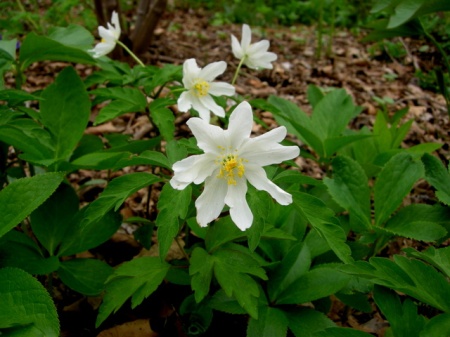Carolyn’s Shade Gardens is a retail nursery located in Bryn Mawr, PA, specializing in showy, colorful, and unusual plants for shade. The only plants that we ship are snowdrops and miniature hostas. For catalogues and announcements of events, please send your full name, location, and phone number (for back up use only) to carolyn@carolynsshadegardens.com. Click here to get to the home page of our website for catalogues and information about our nursery and to subscribe to our blog.
.  European wood anemone ‘Vestal’, Anemone nemorosa
European wood anemone ‘Vestal’, Anemone nemorosa
.
My last post highlighting my epimedium collection was very popular. It set a new record for views in a single day. It was also quite helpful in allowing me to document the collection in photographs. That has inspired me to do a similar post introducing another relatively obscure group of plants blooming right now, European wood anemones or Anemone nemorosa. I first saw them in Charles Cresson’s garden in 1995, and he gave me five cultivars to take home. I have since increased that number to 13 (15 if you count the two that died). I want to share this special plant with you and discuss its culture and garden uses.
.
 ‘Vestal’ is a moderate spreader.
‘Vestal’ is a moderate spreader.
European wood anemone is what is often called a bulb ally. It springs from skinny, stick-like rhizomes that spread through leaf litter to form patches of beautiful flowers and leaves. You can buy the dried rhizomes in the fall like other bulbs or you can buy growing plants in the spring from Carolyn’s Shade Gardens or other specialty nurseries. Wood anemones grow in part to full shade and like woodland soil with lots of organic matter. I have never watered them, but I do mulch them with a covering of ground leaves in the fall. The various cultivars spread at different rates in my woods from slow to fast. I will indicate what type of spreader each one is in my garden, but it may depend entirely on my conditions and where each variety is planted
.
 ‘Robinsoniana’ is a gorgeous blue but a slow grower in my garden.
‘Robinsoniana’ is a gorgeous blue but a slow grower in my garden.
European wood anemones are a spring ephemeral. They take advantage of the sunlight before the woody plants leaf out and then go dormant when it gets hot and shade prevails. Although they disappear, they are still a good groundcover because the rhizomes are so thickly matted that no weeds can grow. Just plant later emerging plants like ferns or hostas around them if the hole will bother you after they disappear.
.
 ‘Leed’s Variety’ spreads moderately.
‘Leed’s Variety’ spreads moderately.
.
 ‘Leed’s Variety’ has the biggest flowers, about 2″ wide, of any of my cultivars.
‘Leed’s Variety’ has the biggest flowers, about 2″ wide, of any of my cultivars.
.
European wood anemones bloom in the mid-Atlantic for the whole month of April and sometimes into May, depending on the weather. Their plentiful flowers are 1 to 2″ wide and generally white, blue, and pink and can be double or semi-double. Many of the cultivars are very similar in appearance. The Royal Horticultural Society’s plant finder lists almost 100 varieties. There are some closely related yellow-flowered forms as well as some weird green-flowered varieties, ‘Virescens’ and ‘Green Fingers’, both of which I have killed. Wood anemones’ leaves are an attractive dark green with three deeply incised segments. They form compact mounds about 6 to 8″ tall.
.
 ‘Wyatt’s Pink‘ is a moderate grower.
‘Wyatt’s Pink‘ is a moderate grower.
.
.
A patch of wood anemones really lights up a woodland opening, and I like to let mine develop as big a swathe as they can manage. They are native to the woodlands and shady banks of western Asia and the northern temperate zones of central Europe, including England where many cultivars have been selected. According to the RHS, they are hardy to zone 5 and another source says zones 5 to 9, but you should do your own research before planting them if you are not in the mid-Atlantic.
.
.
 ‘Bracteata’ is an unusual and very elegant form with the white flower color extending into the leafy bracts.
‘Bracteata’ is an unusual and very elegant form with the white flower color extending into the leafy bracts.
.
European wood anemones are quite easy to grow and well worth adding to your garden if you can find them. Here are some of my other cultivars:
.
 Yellow wood anemone, A. ranunculoides, is closely related to A. nemorosa. It is the first to come into bloom and spreads quickly but not aggressively, even self-sowing.
Yellow wood anemone, A. ranunculoides, is closely related to A. nemorosa. It is the first to come into bloom and spreads quickly but not aggressively, even self-sowing.
.
.
 ‘Lychette’ is a moderate spreader.
‘Lychette’ is a moderate spreader.
.
 ‘Allenii’ is similar to ‘Robinsoniana’ but more silvery blue in color. It is a moderate spreader.
‘Allenii’ is similar to ‘Robinsoniana’ but more silvery blue in color. It is a moderate spreader.
.
.
 I acquired this Anemone nemorosa from the old Heronswood Nursery in Washington with the name “pink form”. It is a moderate grower.
I acquired this Anemone nemorosa from the old Heronswood Nursery in Washington with the name “pink form”. It is a moderate grower.
.
 ‘Alba Plena’ is very similar to ‘Vestal’ but it is a faster spreader.
‘Alba Plena’ is very similar to ‘Vestal’ but it is a faster spreader.
.
.
 Anemone x seemanii is a cross between A. ranunculoides and A. nemorosa, producing this lovely pale yellow flower. It is a moderate grower.
Anemone x seemanii is a cross between A. ranunculoides and A. nemorosa, producing this lovely pale yellow flower. It is a moderate grower.
.
.
 I will end the profiles of my cultivars with this photo of the absolutely exquisite ‘Blue Eyes’, which I also got from Heronswood.
I will end the profiles of my cultivars with this photo of the absolutely exquisite ‘Blue Eyes’, which I also got from Heronswood.
.
Most of the plants in my woodland are allowed to form large patches for a natural look, and European wood anemone fits right in. Here are some photos of how I use it:
.
 Yellow wood anemone filling a large area in front of Virginia bluebells and Celandine poppy.
Yellow wood anemone filling a large area in front of Virginia bluebells and Celandine poppy.
.
 ‘Bracteata’ edging a path with hellebores and checkered lily, Fritillaria meleagris, another self-seeder in my woods.
‘Bracteata’ edging a path with hellebores and checkered lily, Fritillaria meleagris, another self-seeder in my woods.
.
 ‘Lychette’ on a shady slope with Celandine poppy.
‘Lychette’ on a shady slope with Celandine poppy.
.
 ‘Vestal’ and Anemone ranunculoides edge a woodland path with ‘Alba’ across the way to the right of the Virginia bluebells.
‘Vestal’ and Anemone ranunculoides edge a woodland path with ‘Alba’ across the way to the right of the Virginia bluebells.
.
European wood anemones are for sale at Carolyn’s Shade Gardens. If you are not local or you want some of the really special cultivars, you can order them from Arrowhead Alpines in Michigan, a great mail order nursery for unusual woodland plants.
Carolyn
.
Carolyn’s Shade Gardens is a retail nursery located in Bryn Mawr, Pennsylvania, US, zone 6b. The only plants that we mail order are snowdrops and miniature hostas and only within the US.
If you are within visiting distance and would like to receive catalogues and information about customer events, please send your full name and phone number to carolynsshadegardens@verizon.net. Subscribing to my blog does not sign you up to receive this information.
Nursery Happenings: The 2013 Miniature Hosta Mail Order Catalogue, containing choice selections of miniatures for shipping all over the US, is now on the right sidebar here, and we are ready to ship. Next up locally is our hosta, fern, and hardy geranium open house sale on May 11—look for an email if you are on my customer email list (different than a blog subscription).
Facebook: Carolyn’s Shade Gardens has a Facebook Page where I post single photos, garden tips, and other information that doesn’t fit into a blog post. You can look at my Facebook page here or click the Like button on my right sidebar here.
Notes: Every word that appears in orange on my blog is a link that you can click for more information. If you want to return to my blog’s homepage to access the sidebar information (catalogues, previous articles, etc.) or to subscribe to my blog, just click here.










